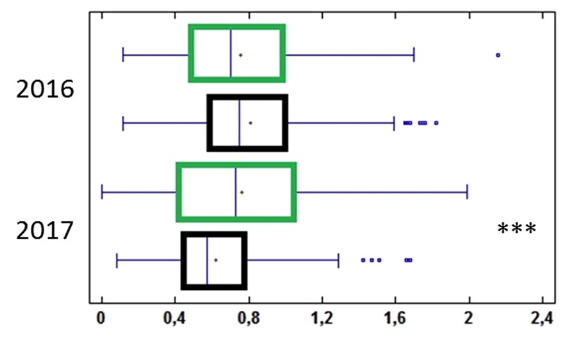Differences in stress reaction between biodynamic and conventional vines
In a paper published in 2018, a French research team examined biodynamic and conventional viticulture methods. The researchers, led by Isabelle Soustre-Gacougnolle, studied how the vines reacted to climatic stress and the effects of disease and fungal attack. Their study showed that vines grown biodynamically reacted more to climatic factors and pathogens than did vines grown by conventional methods. The researchers explained these findings through activation of the immune system of biodynamically grown vines and a raised level of antioxidants and anti-fungal substances. This led them to the conclusion that increased sustainability in biodynamic viticulture is linked to processes at a molecular level.
Despite several studies that point out the benefits of biodynamic viticulture compared to conventional methods, the anthroposophical approach is still disputed amongst farmers. While the biodynamic method focuses mainly on promoting plant health, conventional methods tend to be dedicated to combating disease and unfavourable conditions. Develooping viticulture with fewer impacts on the environment and human health requires a more detailed scientific examination of the plants' own defence mechanisms and how to promote these. This is particularly important because the use and impact of pesticides, while well researched, also entail high environmental costs.
Fourteen test plots were selected for the study, of which eight were managed conventionally and six biodynamically. All the plots have comparable climatic conditions and have been cultivated for over 20 years. The variety chosen was Pinot Noir, a frequently grown grape that is well researched and for which the genome is already fully decoded. A number of parameters related to growing methods were recorded over a four-year period, along with plant health and virus and mildew infections.
Results
Conventional test plots were treated with synthetic fungicides with long-term action, whereas the various preparations used on the biodynamic plots had to be reapplied after rain. Copper and plant protection products containing sulphur were used on all the test plots, but much more sulphur was applied on biodynamic plots than on the conventional ones.
During the trial, the number of plants infected with mildew increased more on the biodynamic plots than on the conventional ones. However, as none of the sampled leaves showed any outer signs of fungal infection, both methods appeared to have effectively slowed down the spread of the infection. In general, synthetic fungicides were more effective against infection, but these have a higher environmental impact. The use of copper is the only environmentally questionable input in biodynamic practice.

Figure 1: Amounts of substances applied on conventional (black) and biodynamic (green) areas. Sulphur; Copper; mTFI = modified Treatment Frequency Index . The mTFI shows the total substances applied minus sulphur and copper. Calculation: product dose used x plot surface sprayed/recommended dosage x total plot surface. Sum of treatments = sulphur + copper + mTFI
The reaction of the vines to drought was measured from the frequency of defence genes and secondary metabolites, which are associated with the plants' immune reaction amongst other things. The researchers were able to establish a clearer reaction to drought in the biodynamic vines than in the conventionally grown ones, expressed in higher gene activation. The greater the drought stress, the clearer were these differences. As a possible cause of this, the researchers cite the use of manure and biodynamic preparations instead of synthetic fungicides in the biodynamically grown plants.
The observations on fungal and virus infection are similar, though less marked. The data suggest that genes linked to the vines' immune reaction are more strongly expressed in the biodynamic vines than in conventional viticulture. Leaves from vines under conventional management display more chlorophyll while those from biodynamic vines contain more substances with antioxidant properties, such as flavonols.
In 2016 weather conditions were favourable for viticulture. For this year there were no clear differences in mean weight between biodynamic and conventional growing methods. In 2017, a year marked by drought stress, the average weight of the biodynamically grown vines remained constant while that of the conventionally grown ones showed a marked decrease. The researchers postulate that increased resistance to climatic stress in the biodynamic vines conserved the plants' energy reserves, thus stabilising the yield.

Figure 2: Average weight of conventional (black) and biodynamic (green) vines in kg/plant, shown as box plots. 3 stars (***) indicate a high statistical significance (Wilcoxon-Mann-Whitney test P≤0.0001).
Conclusion
Despite the correlations, no clear causality could be established between the biodynamic preparations and the observed plant reactions. Neither the composition nor the effect of the preparations have been studied and understood well enough to date, with the result that biodynamic preparations are still controversial amongst many winegrowers. The complex interactions of different factors also makes it more difficult to make statements from holistic studies.
As this study did not consider organic growing methods, the possibility that the observations made on biodynamic methods might also apply to organic methods cannot be ruled out. Differences can be seen between biodynamic and conventional viticulture. The researchers refer to a "biodynamic-specific reaction to the factors of climate and pathogens". Cooperation between different stakeholders as part of participative research can help to reduce the environmental and health impacts of viticulture by optimising management practices.
Details of the original publication
Authors: Soustre-Gacougnolle, I., Lollier, M., Schmitt, C. et al.
Title: Responses to climatic and pathogen threats differ in biodynamic and conventional vines
Journal: Scientific Reports. Sci Rep 8, 16857 (2018).
Link (Open Access): https://doi.org/10.1038/s41598-018-35305-7